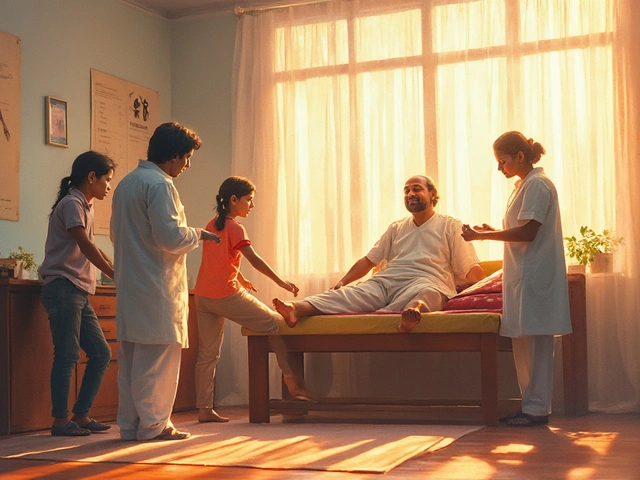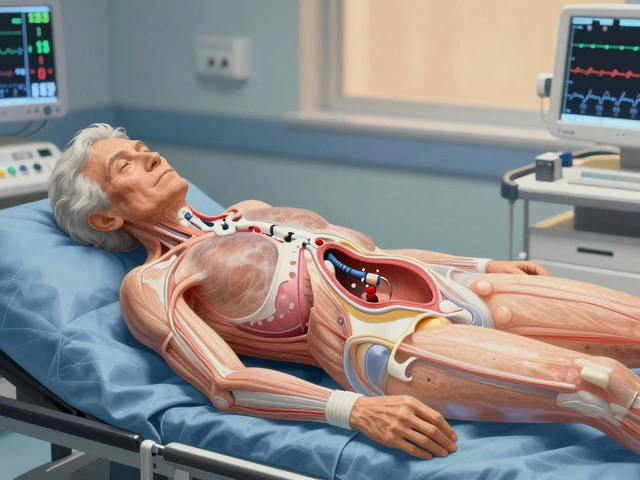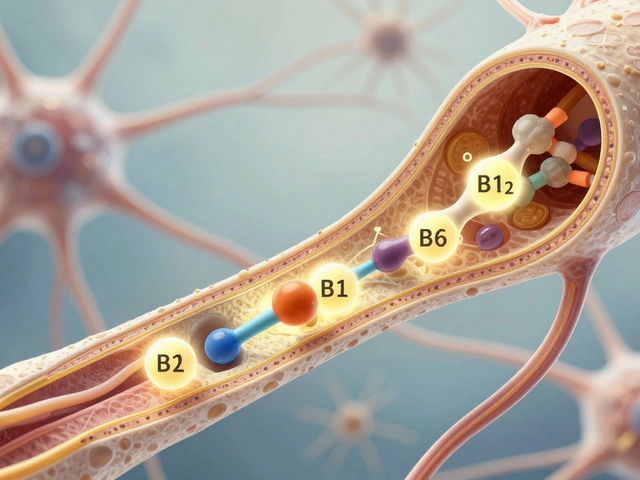Ever wondered what the number one most painful heart surgery is? You might think all surgeries hurt, but when it comes to the heart, it’s a different ball game altogether. Heart surgeries are no picnic, but breaking open the chest is as painful as it sounds.
Open heart surgery takes the crown for being extremely painful. Imagine this: doctors crack open your ribcage to get to your heart. Sounds intense, right? It involves working inside the heart or its arteries, and that’s why recovery can feel like an uphill battle.
Why is it so painful, you ask? First off, there's the fact they’re literally opening up your chest and poking around vital organs. It’s major trauma. The pain isn’t just physical—it’s emotional too. After all, it's the heart we’re talking about.
If you or someone you know is gearing up for this surgery, knowing what affects pain levels can be a lifesaver. How fit you are, your age, and how complex the surgery is all play a part. But don’t worry, the worst seems more manageable when you know what you’re in for.
- The Scene of Heart Surgery
- The Most Painful Procedure
- Why It Hurts So Bad
- Factors That Influence Pain
- Recovery: What to Expect
- Making Recovery Easier
The Scene of Heart Surgery
So, you're about to learn what happens when someone goes under the knife for heart surgery. It’s not some quick stitch-up job; it’s a dance of precision and a test of endurance, both for the patient and the surgical team. When you think about the operating room, picture a clean, organized space filled with beeping machines, surgical tools, and a team of specialists working in sync.
The patient is under general anesthesia. That means they’re completely out, with no sensation or awareness. So, no pain right then and there. The surgeon makes an incision down the middle of the chest to access the heart directly. This is why it’s called open heart surgery, and trust me, it’s a sight you'd probably not want to see unless it's your job.
Here’s a fun fact: sometimes they have to stop the heart for a bit, using a heart-lung bypass machine to keep the blood pumping. This machine does the heart’s job temporarily— it’s like putting your heart on vacation while the surgeons do what they need to do.
The whole thing can take several hours. Some procedures last 3-6 hours or even longer, depending on what needs fixing. For instance, bypass surgeries or valve replacements might take a different amount of time, given the complexity.
You might be surprised to know that over 200,000 open heart surgeries are performed each year in the U.S. alone. That’s a lot of people trusting their lives and hearts to medical science, and it's fascinating how far we’ve come.
| Procedure | Approx. Duration | Common Purpose |
|---|---|---|
| Coronary Artery Bypass | 3-6 hours | Improve blood flow |
| Valve Replacement | 2-4 hours | Replace damaged valves |
So, while open heart surgery sounds dramatic, it’s often the most effective way to treat serious heart issues. It's crucial for saving or improving lives, even if it involves a lot of work and a bit of pain afterwards. Now you know what goes down in that brightly lit operating room, from the beeping machines to the surgical team’s steady hands. It’s surgery at its peak!
The Most Painful Procedure
We're diving into heart surgery territory that’s known to be, well, incredibly unpleasant. The top spot for the most painful heart surgery often goes to the CABG—Coronary Artery Bypass Grafting. This procedure is no walk in the park as it involves a complex process of using a healthy artery or vein from your body to bypass blocked arteries in your heart.
Imagine what it takes: opening the chest to get direct access to the heart. During the surgery, the heart might be stopped, and a machine takes over the job of circulating blood. It sounds like sci-fi, but it's been a life-saving practice for years now. What adds to the city's stress is the tissue trauma from opening the chest and cutting through bone—it's major league pain in the aftermath.
Now, you might be thinking, “Why does CABG hurt more than other surgeries?” For starters, the sheer size of the incision and the invasion into the chest cavity set it apart. Plus, the healing required for the sternum, which is cut during the procedure, can take weeks and is quite brutal.
But before you get too worried, remember that millions of people go through this every year. Surgeons have got this down to an art, and there are ways to manage the pain. Pain management specialists work closely with patients to tailor a plan that eases post-surgery discomfort. Modern medicine's got your back, literally!
Want some numbers to chew on? According to recent studies, about 200,000 CABG surgeries are performed in the U.S. each year. That's a lot of people coming out stronger on the other side. So while it’s daunting, know that there’s a path to healing.
Why It Hurts So Bad
So, why does open heart surgery hurt so much? Well, let's break it down. First off, during the surgery, your ribcage is literally cracked open. Yup, like cracking open a coconut. This major operation involves cutting through skin, muscles, and bone to reach the heart. Now, that’s got to sting a little, wouldn’t you say?
According to Dr. Richard Cohen, a renowned cardiac surgeon, "The pain from heart surgery primarily stems from trauma to the chest wall and inflammation around the surgical site."
On top of that, the heart needs to be stopped momentarily and a heart-lung machine takes over. It's as intense as it sounds. After the surgery, you have to deal with a lot of soreness as your body starts the healing process.
A lot of this pain also comes from the body’s natural healing response. Think of it this way: your body is trying to fix a pretty big mess and sends all its repair troops in, causing inflammation and swelling.
Here are some key factors contributing to the pain:
- Surgical Incisions: Large incisions mean more pain, plain and simple.
- Chest Tubes: Tubes inserted during surgery can seriously add to the discomfort.
- Nerve Pressure: Opening the chest can press on or even damage nerves temporarily, causing sharp pain.
And let's not forget the emotional toll. Stress and anxiety can increase the perception of pain. So, staying calm and following the doctor’s recovery plan can make a real difference. Bottom line? This surgery is no joke, but with the right info, you can be prepared for what's coming.

Factors That Influence Pain
When it comes to heart surgery, not everyone feels pain the same way. It's kind of like spicy food—what's mild for one person is fiery hot for another. So, what exactly makes a difference in how we feel pain after open heart surgery?
First off, age plays a massive role. Younger folks tend to bounce back quicker. Their bodies heal faster, and the pain tends not to last as long. On the flip side, older adults might face a tougher time because their bodies heal more slowly.
Then there's your physical condition. Are you a fitness fanatic or more of a couch potato? An active lifestyle usually means better recovery. If you're used to moving around, your body is in better shape to handle trauma.
Don’t forget about the complexity of the surgery itself. Some procedures are more involved than others, meaning more time under the knife and, unfortunately, more pain. A simple bypass might not be as rough as a surgery where they have to fix multiple things at once.
Pre-existing health conditions can muddy the waters too. Diabetes, obesity, or lung problems can complicate the recovery process, making it longer and sometimes more painful.
Let's not overlook the emotional aspect. Anxiety and stress about the surgery can amplify how bad pain feels. It's like a vicious cycle—the more stressed you are, the more it seems to hurt.
Here’s a nifty little table to summarize some of these factors:
| Factor | Impact on Pain |
|---|---|
| Age | Older age can increase pain perception |
| Fitness Level | Better fitness usually means less pain |
| Complexity of Surgery | More complex surgeries lead to more pain |
| Pre-existing Conditions | Conditions like diabetes can worsen pain |
| Emotional State | High stress can increase pain |
So, there you have it. Knowing these factors could help you prepare better or at least give you something to think about, whether you're going through this yourself or supporting someone who is.
Recovery: What to Expect
Alright, you've come out of heart surgery, and now the real journey begins—recovery. It’s crucial to set your expectations straight. You’re not going to bounce back overnight, but knowing what's ahead can make things way less stressful.
First off, let’s look at the time frame. Most patients spend about a week in the hospital right after the surgery. The initial days are all about making sure your heart and body are stabilizing. You’ll have tubes and monitors doing their job—don’t let that freak you out.
Once you're home, it takes about six to eight weeks to get back to normal activities. But again, everyone’s different, so listen to your body. Expect some aches and pains—after all, you’ve been through a painful surgery. Your sternum, the bone in the middle of your chest that was cracked open, is healing, which means activities like lifting and driving are out for a while.
As you’re healing, you’ll want to gradually reintroduce yourself to movement with light activities and short walks. It’s a balance; you don't want to push too hard, but you don’t want to lag either.
Here’s a cheat sheet to help you out:
- Follow-up appointments are crucial. Don’t skip them. Your doctor needs to see how your heart is doing.
- Expect a bunch of medications: blood thinners, pain relievers, you name it. Stick to the prescribed doses.
- Managing your mood is important. Many feel down post-surgery, and it's normal. Talk about it with friends or even seek professional help if needed.
Pacing yourself is key here. A common mistake is trying to do too much too soon. Recovery is a process—you’ll see improvements in weeks 5 and 6, where movement feels less exhausting, and pain levels drop significantly.
Remember, your heart is kind of a big deal—treat it well, be patient, and you’ll be back on your feet and feeling like yourself in no time.
Making Recovery Easier
So, you've made it through the heart surgery—now what? Recovery is a big deal, and making it easier is all about what you do afterward. Let’s break it down so you're back on your feet in no time.
First up, follow your doctor's orders to the letter. It might sound basic, but sticking to the recovery plan is crucial. If they say rest, then get cozy and rest. It's not the time to be a hero.
Pay attention to your pain management. If meds are prescribed, make sure you take them as instructed. Sometimes people try to tough it out, but this isn’t the time for that. If they don't cut it, reach out to your doc. They might tweak the dosage or try something different.
Speaking of moving around, gentle exercise is your best friend. We're talking simple, low-impact movements like walking. It helps with circulation and keeps those muscles from getting too stiff. Plus, it can lift your mood. Just make sure you're not overdoing it.
Your diet plays a huge role in recovery. Load up on fruits, veggies, lean proteins, and whole grains. Keep an eye on salt intake since too much can raise blood pressure.
Here’s a quick checklist to keep you on track:
- Rest when you’re tired, but get moving with short walks as instructed.
- Stay on top of your medication schedule.
- Go for nutritious foods to fuel recovery.
- Stay connected with family and friends for emotional support.
Some folks find it helpful to keep a recovery journal. Jot down how you feel each day, your progress, and any questions you might have for the doctor. It's a small thing but can help spot patterns in your recovery journey.
Remember, patience is key. It took a lot to get through open heart surgery and feeling better won’t happen overnight. But with some smart moves, you’re on your way to a smoother recovery.










